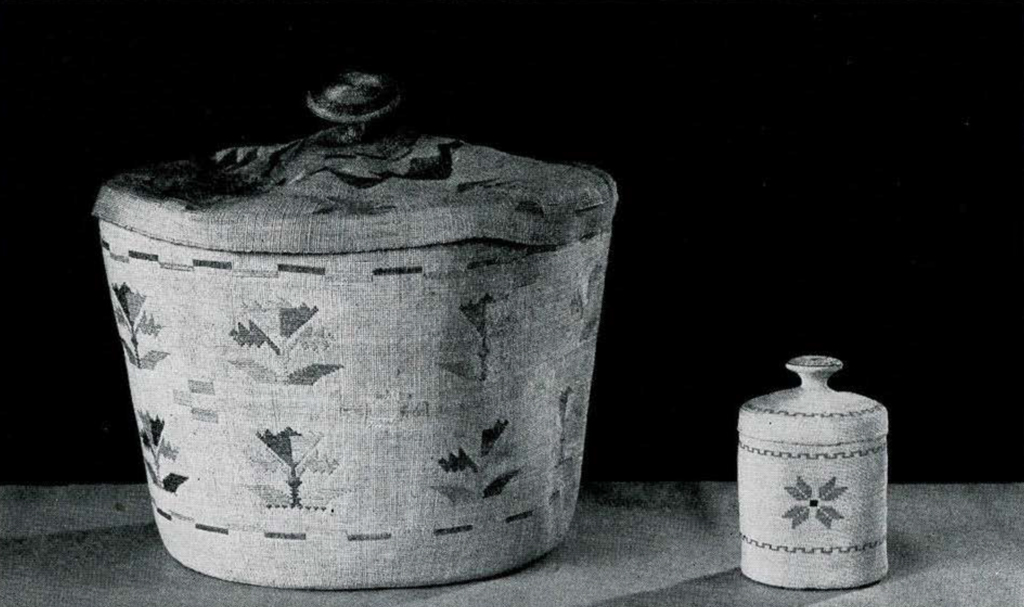FOR Attu, the international date-line deflects from its even curve, thus, in the sense of time, annexing to our hemisphere this westernmost inhabited island of the Aleutian chain. Early Russian explorers found there, settled along its rocky shores, the fearless and self-reliant Aleut, representatives of the far-flung Eskimoan stock.
Their history is tragic. Their numbers were soon decimated by the cruelties of the fur-traders, and later greatly reduced by a smallpox epidemic. Christianized by the devoted missionaries of the Greek Orthodox Church, there has been considerable race mixture with the Russians. When, in the recent war, the Japanese overran the Aleutian Islands, these peaceful Attu natives – ninety-six men, women and children – were carried into captivity.

Museum Object Numbers: NA3285 / 31-23-3
Image Number: 12154
The little village of Attu, on Chicagof Bay, is now as desolate as the many ancient villages and burial grounds that dot the indentations of the island’s ragged coastline. From one such site, on Little Mike Point on the south shore, the University Museum has recently received a collection of stone and bone artifacts, together with a complete skeleton – the gift of Lieut. Com. C. C. Chapple. While not spectacular, being largely utilitarian, the tools of a hard life that left scant time for beauty, there are examples of fine workmanship, especially in bone, such as the slender sinew-splitter, double pointed, with a central perforation for a thread by which it hung from the wrist of the worker – too valuable a tool to risk its loss.
The highest artistic attainment of the Attu islanders is not to be found in graves, but in museums and private collections – the exquisite Attu baskets. The women gathered and carefully cured the beach grass, a species of wild rye, to be woven into fine cylindrical storage baskets with flat lids topped by a knob, like the button on an old-time Russian sailor’s hat. These baskets sometimes had a diameter of more than 14 inches and a fineness of twenty to thirty stitches to the inch. Because of the great number and fineness of the warps, this basket was woven in an inverted position. The bottom disc having been formed by two-strand twining upon radiating warps, it was hung from a pole, usually projecting from the house wall, and, with all its slender warps dangling, the intricate weaving proceeded (Plates VII, VIII).
The beauty of the Attu basket lies in the delicacy and variety of its weaves, often showing a lacelike effect. Variations are produced by the manipulation of the warps. In simple form, the rows of twining weft may be driven close upon one another, giving a neat, firm texture, or they may be spaced to leave slits between the parallel warps. More elaborate is the crossed warp technique in which alternate strands move to the right and to the left; the result of the twining upon these is to give open-work with hexagonal mesh. In other baskets, the warps are paired, the units of the divided warps separating and reuniting in succeeding rows at will, to form a gauzelike texture. In a single basket, any combination or all of these may occur, the weaver passing smoothly from one form to another. A curious character of many of these cylindrical baskets is the lacy openwork of the bottom, so ill adapted to the usual purposes of a container.

Museum Object Numbers: NA3283 / NA8979 / NA3284
Image Number: 12155
The other form of basket made on Attu was a small wallet in two parts, sometimes termed cigar-case. Originally woven as a slender cylinder, it was intended to be folded flat and the two pieces telescoped. These cases are of exceeding fineness, sometimes showing 40 stitches and 38 rows to the inch. Like the cylindrical basket, they are ornamented with colored design in overlay or false embroidery. Originally the weaver depended wholly upon natural materials or tints produced by conditions of curing, to create differences of tone. These, in the last century, gave way to fine silk thread, later to mercerized and woolen yarns, which brought to their creations more vivid colors, not always lasting.
In the last twenty years there have been three women of Attu, who were noted for their excellency in weaving: Anastasia, wife of the village chief, Michael Gorga Hodikoff, Maggie Prokopioff, his aunt, and Mary Snigaroff, the last of whom was left-handed. This physical peculiarity in a weaver of baskets results in a reversal of the direction of weave. Now and then such an Attu basket, with twined stitches slanting in a direction opposite to the normal, is found in a collection, and may safely be attributed to Mary Snigaroff.
With the probable extinction of the Attu natives, their baskets, always rare, are greatly enhanced in value. The University Museum is fortunate in possessing a noteworthy collection of these beautiful examples of primitive art.
H. N. W.

